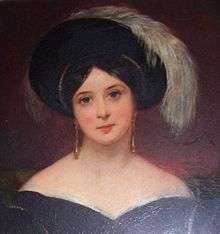Louisa Lawrence
Louisa Lawrence (1803–1855) was an English horticulturist in the second quarter of the 19th century.[1]

Life
Louisa Senior was born to James Senior and Elizabeth Trevor, of Broughton House, on the outskirts of Aylesbury. James had made his money as a haberdasher in Bruton Street, Berkeley Square, London. Like her father, Louisa had social ambitions. After she married the surgeon William Lawrence in 1828 when she was 25 and he was 45, her social ambitions were gratified by horticulture, first in a villa with less than two acres at Drayton Green. In her comparatively small garden she cultivated over 200 orchids and over 500 varieties of roses, long before hybrid tea roses and perpetuals were fashionable. There were Italian pollarded walks, rockwork including a rustic arch (with Cupid), a French parterre, a span-roofed greenhouse, a stove and an orchid house. By 1838 a detailed account of this model of what a suburban garden could be made into was published in The Gardener’s Magazine.[2]
In June 1838 Sir Lawrence purchased the property of nearby Ealing Park (or Little Ealing) containing 100 acres, at a purchase price of £9000.[3] It is described by Pevsner as “Low and long; nine bays with pediment over the centre and an Ionic one-storeyed colonnade all along”.[4] The property was grandly furnished, as may be seen from the catalogue of the sale of the contents after Louisa’s death.[5] The estate boasted livestock, including poultry of all sorts, cows, sheep and pigs. There were thousands of bedding plants, “stove plants”, more than 600 plants in early forcing houses, nearly a hundred camellias, and more.
An indication of Louisa’s celebrity is that two influential gardening books were dedicated to her in the early 1840s. In 1841 Mrs Loudon, wife of the editor of The Gardener's Magazine, wrote The Ladies’ Companion to the Flower Garden, being an Alphabetical Arrangement of all the ornamental plants usually grown in gardens and shrubberies, with full directions for their culture. She dedicated it to Mrs Lawrence of Ealing Park, Middlesex, “as a zealous patron of floriculture, an excellent botanist, and, above all, as one of the first lady-gardeners of the present day”. Vol. LXVIII of Curtis’s Botanical Magazine, the work of Sir William Jackson Hooker, the director of the Royal Botanic Garden was dedicated “with sentiments of great regard and esteem” to Mrs Lawrence, “the beauty of whose gardens and pleasure grounds and whose most successfully cultivated vegetable treasures are only equalled by the liberality with which they are shown to all who are in botany and horticulture”.
Louisa was extremely competitive, constantly winning prizes for herself and her gardens at shows organised by the Botanic Society, the Royal Horticultural Society, and others.[6] One of her keenest rivals was Joseph Paxton, the Duke of Devonshire’s famous gardener at Chatsworth in Derbyshire. Paxton and the Duke visited Louisa's estate in 1841, although it appears that Paxton did not like her. Louisa’s greatest triumph was in 1849, and very much over the Duke and Paxton. For eighty years or so botanists had been bringing back to Europe previously unknown plants from all over the world, and they were eagerly cultivated. There was a race among English horticulturists to produce the first flower of a beautiful tree from Burma, the Amherstia nobilis. Mrs Lawrence succeeded, sending the first spike to the Queen and the second to be engraved. A third spike was sent to Chatsworth, and it sent the Duke and Paxton into raptures at its beauty. She was also the first to grow the purple-blue climbing nasturtium, Tropaeolum azureum.[7]
At Ealing Park, Louisa’s ambitions became even more serious, and she was even more definitely on the fashionable visiting circuit. In 1844 Carl Gustav Carus, doctor to the King of Saxony’s doctor, writing in his diary about Louisa’s husband, noted: “His wife is celebrated as one of the first flower cultivators in London, and possesses in particular a beautiful collection of orchideous plants, which we shall probably visit on some other occasion.” The king’s party did go a few days later and Carus was amazed by both the flowers and the elegant grounds.[8] Grander still was the visit of Queen Victoria, the Prince Consort, the King of the Belgians, and the Grand Duke of Mecklenburg-Strelitz, who planted the first trees in a planned avenue of deodars, the Himalayan cedar which had been introduced to England not long before, in 1831.[9]
Louisa and William had two sons and two daughters. The elder son died in childhood; the younger, Trevor, became as celebrated a gardener as his mother, and was a president of the Royal Horticultural Society. After Louisa's death, her husband, who had been chiefly living in Whitehall Place, leased Ealing Park. Trevor later sold it out of the family.
References
- ↑ Dictionary of British and Irish. Botanists and Horticulturists, Ray Desmond, 1994; Biographical Dictionary of British Gardeners, Hadfield, Harley, Highton, 1980
- ↑ Journal of RHS Sept 1955 quotes Loudon in The Gardener’s Magazine July 1838
- ↑ History & Antiquities of Brentford, Ealing & Chiswick, Thomas Faulkner, 1845
- ↑ Middlesex, Buildings of England, Nicholas Pevsner, 1951
- ↑ Copy of catalogue in possession of Aubrey Lawrence, of Brue-Auriac, Provence
- ↑ The Royal Horticultural Society A History 1804-2004, Brent Elliot, 2004
- ↑ Kate Colquhoun, A Thing in Disguise: The Visionary Life of Joseph Paxton 2003
- ↑ Carus C.G.. The King of Saxony's journey through England and Scotland in 1844, 1846
- ↑ Jenny Uglow, A Little History of British Gardening, 2004